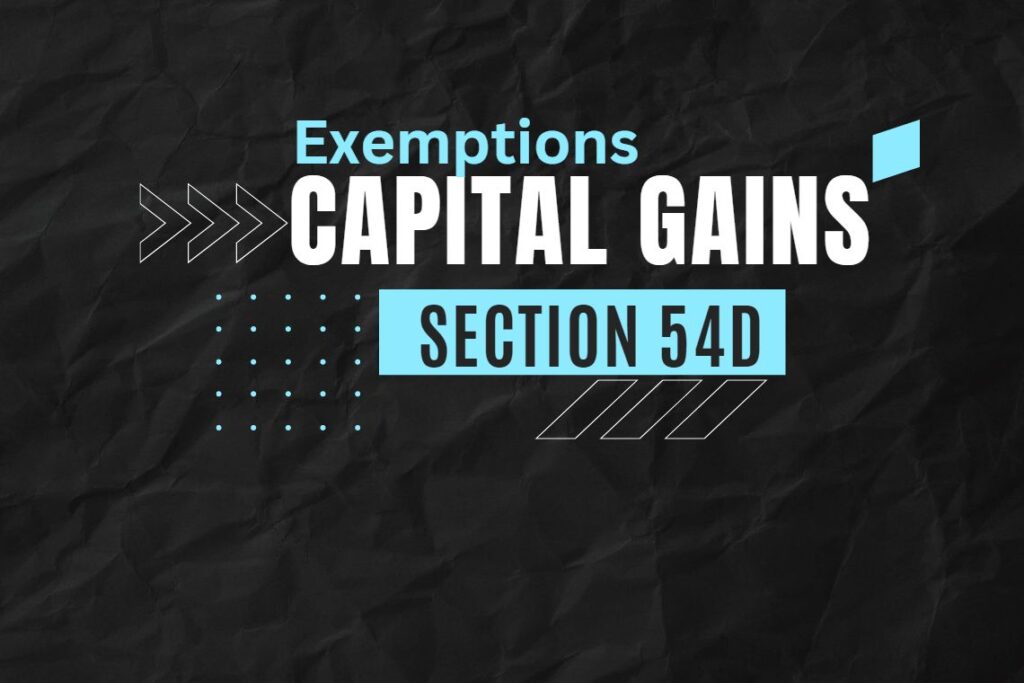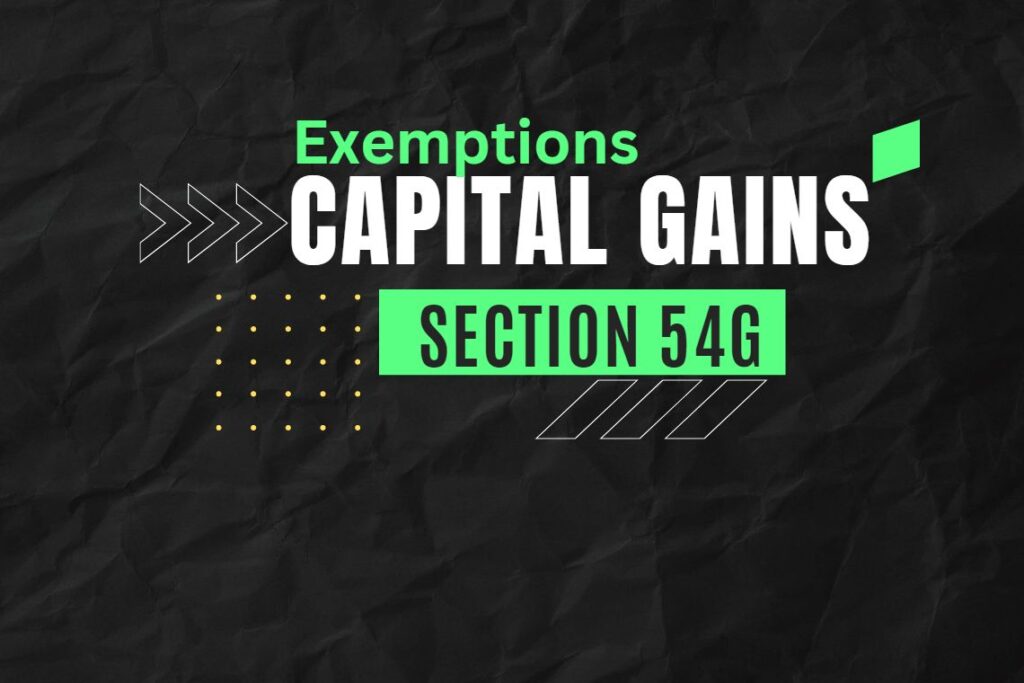As per Section 54D, the Capital Gain arising from the transfer, by way of compulsory acquisition under any law, of land or buildings forming part of an industrial undertaking belonging to the assessee are Exempt, if the following conditions are satisfied:
(i) the transfer is by way of compulsory acquisition of the asset;
(ii) the asset transferred is land or buildings forming part of an industrial undertaking belonging to the assessee;
(iii) such land or buildings were in use by the assessee for the purpose of the business of the industrial undertaking for at least 2 years immediately preceding the date of transfer;
(iv) capital gain on compulsory acquisition of land and buildings can be short-term or long-term. However, since building is being used for business, it is a depreciable asset and therefore, capital gain on transfer of such building, even if, it is held for more than 3 years, will be a short-term capital gain. Land is however, not a depreciable asset and as such the period of holding will be important for computing long-term/short-term capital gain;
(v) the assessee purchases/constructs other land and buildings within a period of 3 years after the date of transfer for the purpose of shifting or re-establishing the said industrial undertaking or setting up another industrial undertaking.
Quantum of deduction
- If the amount of capital gain is equal to or less than the cost of the new asset, the entire capital gain shall be exempt.
- If the amount of capital gain is greater than the cost of the new asset, the cost of the new asset shall be allowed as an exemption.
In other words, capital gain shall be exempt to the extent it is invested in the purchase/construction of new land/building for the industrial undertaking.
Provisions of Section 54D and the Conditions that need to be fulfilled to claim the Exemption
When the government acquires land and buildings for public purposes, it is required to compensate the owners for their loss. This compensation often includes the payment of capital gains tax on the appreciation in the value of the property since its acquisition. However, under Section 54D of the Income Tax Act, certain exemptions are available for the compulsory acquisition of land and buildings forming part of an industrial undertaking. This blog post will explore the provisions of Section 54D and the conditions that need to be fulfilled to claim the exemption.
Section 54D – An Overview
Section 54D provides an exemption from capital gains tax on the compulsory acquisition of land and buildings forming part of an industrial undertaking. The objective of this provision is to encourage industrial development and ensure that the owners of such properties are not burdened with a hefty tax liability when their assets are acquired by the government.
To be eligible for the exemption under Section 54D, the following conditions need to be fulfilled:
- The land and buildings must be forming part of an industrial undertaking.
- The industrial undertaking must be owned by the taxpayer.
- The taxpayer must use the compensation received for acquiring a new industrial undertaking.
Conditions for Claiming the Exemption
The first condition for claiming the exemption is that the land and buildings must be forming part of an industrial undertaking. This means that the property should be used for industrial purposes, such as manufacturing, processing, or production of goods. The industrial undertaking can be owned by a company, partnership firm, or individual.
The second condition is that the industrial undertaking must be owned by the taxpayer. This means that the taxpayer should have a legal ownership or leasehold rights over the property. If the property is jointly owned, each owner can claim the exemption in proportion to their ownership.
The third condition is that the compensation received for the compulsory acquisition must be used for acquiring a new industrial undertaking. This means that the taxpayer cannot use the compensation for any other purpose, such as personal expenses or investments in non-industrial assets. The new industrial undertaking must be acquired within a specified time period to claim the exemption.
Benefits of the Exemption
The exemption under Section 54D provides several benefits to taxpayers. Firstly, it helps in reducing the tax burden on the capital gains arising from the compulsory acquisition of land and buildings forming part of an industrial undertaking. This can result in significant tax savings for the taxpayers.
Secondly, the exemption encourages industrial development by ensuring that the owners of industrial properties are not discouraged from selling their assets due to the tax implications. This promotes the efficient allocation of resources and encourages investment in new industrial undertakings.
Conclusion
Section 54D of the Income Tax Act provides an exemption from capital gains tax on the compulsory acquisition of land and buildings forming part of an industrial undertaking. The exemption is subject to certain conditions, including the use of the compensation for acquiring a new industrial undertaking. By providing this exemption, the government aims to promote industrial development and reduce the tax burden on taxpayers. It is important for taxpayers to understand the provisions of Section 54D and fulfill the necessary conditions to claim the exemption.
Key Points of Section 54D
Here are the key details related to this provision:
1. Eligibility:
To be eligible for the exemption under Section 54D, the following conditions must be met:
- The capital asset being transferred should be land and/or buildings.
- The land and/or buildings should form part of an industrial undertaking that is being compulsorily acquired by the government or a statutory authority.
2. Utilization of Sale Proceeds:
The exemption is available if the sale proceeds from the compulsory acquisition are reinvested in the purchase of land or buildings for use in another industrial undertaking within the stipulated time frame.
3. Time Limit for Reinvestment:
The taxpayer is required to utilize the sale proceeds for the purchase of the new land or building within three years from the date of the compulsory acquisition. Alternatively, they can also invest in such land or building one year before the date of the compulsory acquisition.
4. Exemption Amount:
The exemption under Section 54D is limited to the amount of capital gains arising from the compulsory acquisition. In other words, the entire capital gains amount is eligible for exemption if it is reinvested in the specified assets.
5. Tax Implications:
If the entire amount of capital gains is not reinvested in the specified assets within the prescribed time frame, the unutilized portion of the capital gains will be taxable in the year of transfer.
6. Declaration:
To claim this exemption, the taxpayer should declare their intention to invest the capital gains in the new assets in the prescribed manner.
7. Conditions for Continuance of Exemption:
The new industrial undertaking for which the land or building is acquired must also be set up within three years from the date of the compulsory acquisition.
Scheme of Deposit in Capital Gains Accounts Scheme, 1988
The scheme of deposit is applicable, in this case also. In other words, the assessee should either purchase the agricultural land and/or deposit the amount under the Capital Gains Accounts Scheme on or before the due date of furnishing the return of income. The amount so spent/deposited, by the due date of furnishing the return, shall be treated as if it were used for the said purpose.
The proof of such a deposit shall be attached with the return. In this case, the amount already utilised by the assessee for the purchase of the agricultural land, along with the amount so deposited, shall be deemed to be the cost of the agricultural land and shall be eligible for exemption.
Consequences where the Amount Deposited in the Capital Gains Accounts Scheme is not utilized for the Purchase or the Construction of Land/Building for the Industrial Undertaking within the Specified Period:
The amount not so utilised shall be charged as capital gains of the previous year in which the period of 3 years from the date of transfer of the original asset expires and it will be short term or long-term capital gain, depending upon the fact whether the capital gain at the time of the original transfer was a short-term or long-term capital gain. In this case, the assessee shall be eligible to withdraw the amount from the scheme.
| 1. It may be observed that exemption u/s 54D is avaflable to all assessees including companies, which own industrial undertakings.
2. The unutilised deposit amount in the Capital Gains Accounts Scheme, 1988 in the case of an individual, who dies before the expiry of the two/three years stipulated period under sections 54, 54B, 54D, 54F and 54G, cannot be taxed in the hands of the deceased. This amount is not taxable in the hands of legal heirs also as the unutilized portion of the deposit does not partake the character of income in their hands but is only a part of the estate devolving upon them. 3. In the case of transfer by way of compulsory acquisition by the Government, the period of 3 years for acquiring the new asset shall commence from the date of receipt of the compensation and not from the date of acquisition. Similarly, deposit under the Capital Gains Accounts Scheme may be made in the previous year in which the compensation is received or till the due date of filing of the return of income of the previous year, in which the compensation is received. |
Consequences where the New Asset is Transferred within a period of 3 years of its Purchase or Construction:
In this case, the capital gain which was exempt under this section earlier, shall be reduced from the cost of the new asset for the purpose of computation of capital gain in respect of the transfer of the new asset.











